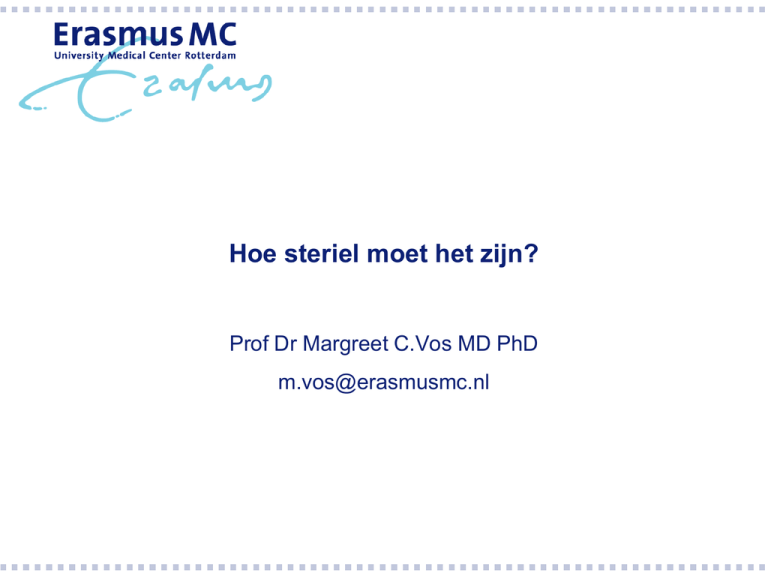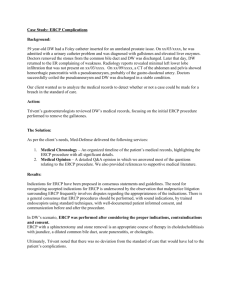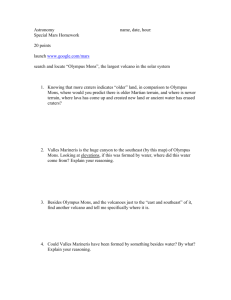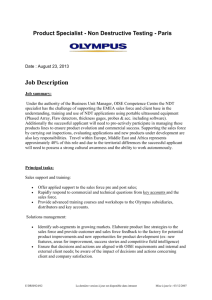Olympus TJF-Q180V (USA
advertisement

Hoe steriel moet het zijn? Prof Dr Margreet C.Vos MD PhD m.vos@erasmusmc.nl Disclosure slide for speakers Disclosure of speaker’s interests (Potential) conflict of interest None Potentially relevant company relationships in connection with event Company names Sponsorship or research funding Fee or other (financial) payment Shareholder Other relationship, i.e. … ·NO ·NO ·NO ·No 2 Table of contents Introduction Breaking news Essential instrument Complex design Problem Erasmus MC outbreak Worldwide outbreaks Solution Short and long term measures Table of contents Introduction Breaking news Essential instrument Complex design Problem Erasmus MC outbreak Worldwide outbreaks Solution Short and long term measures Breaking news ERCP: an essential instrument Drainage of pancreatic and biliary ducts ERCP procedures The Netherlands: 17,000/yr. United States of America: 660,000/yr. Contamination with bacteria and possibly viruses Reprocessing of all flexible endoscopes ‘Bed-side’ cleaning Manual cleaning Automated cleaning and high-level disinfection ERCP: complex design Initial design: Novel design: Side-facing tip Sealed protection cap Elevator for guidewire or catheter Sealed elevator wire channel Elevator wire channel Verfaillie et al. 2015 TJF-Q180V duodenoscope Design: Bron: Product Brochure Olympus F1322SE-1109 Table of contents Introduction Breaking news Essential instrument Complex design Problem Erasmus MC outbreak Worldwide outbreaks Solution Short and long term measures The start… 2012; High incidence VIM positive Pseudomonas aeruginosa (25 patients) Positive culture of desinfected Endoscope Olympus TJF-Q180V 13 months in use 14th March 2012 stop using TJF-Q180V Persistent contamination: outbreak risk 2012: outbreak in Erasmus MC 22 patients infected Identical VIM-2 clone isolated from: Forceps elevator recess Protection cap No breaches in reprocessing procedures Verfaillie et al. Endoscopy 2015 Today and the future……………?? Is this a local problem? Is this a design problem? Is this a cleaning problem? Is this a disinfectionproblem? Is this….? Will this problem be solved with new generations ERCP-endoscopes? What about other designs? Today and the future…………… The solution o Changing design? o Innovative reprocessing? Cooperation hospitals Manufacturers, IGZ / RIVM/TUD in research Table of contents Introduction Breaking news Essential instrument Complex design Problem Erasmus MC outbreak Worldwide outbreaks Solution Short and long term measures ERCP outbreaks: a worldwide problem 2015 may FDA meeting Six Conclusions After 2 days of discussion and deliberation, the advisory panel reached conclusions to questions posed by the FDA in six broad topic areas. 1. Safety of duodenoscopes and AERs The benefits of ERCP procedures far outweigh the risks of contracting a rare infection from a contaminated device, the panel advised. Two thirds of the panel strongly favored sterilization over high-level disinfection, as well as reclassification of duodenoscopes as critical devices. The majority felt that manual cleaning is critical, but that it needs improvement, including some level of competency testing, validation, and training. Six Conclusions 2. The role of premarket human factors in developing reprocessing instructions The panel felt that premarketing human factors testing is important in the development of reprocessing instructions, but that testing may need to be evaluated differently for manual cleaning, AERs, and sterilizers. There was a split vote over whether certification of technicians should be required. There was a universal call, however, for a set of best practices and means of assessing competency in cleaning. Six Conclusions 3. Ensuring adequacy of brushes and flushing aids, which are not FDA regulated The panel did not reach definitive conclusions on this issue. They did recommend, however, that devices be used in accordance with manufacturer specifications, and they called for making available as much information as possible to understand the adequacy of certain brushes, flushing aids, etc. The panel was of the opinion that the FDA does not have a responsibility to ensure that these types of products perform as intended. One unresolved issue is that Olympus released new brushes in May 2015. Data about these new brushes have not yet been reviewed. Whether they could improve reprocessing of duodenoscopes is currently unknown. Six Conclusions 4. Should hospitals be mandated to follow the CDC interim guidance issued in March 2015? The CDC interim guidelines are not sufficient in their current form to be implemented as best practices guidelines, and hospitals should not be mandated to follow them. The concept of developing a best practices document is desirable, but such a document does not yet exist. Six Conclusions 5. Ensuring patient safety during ERCP procedures Hospitals need to have processes in place to ensure patient safety. Diagnostic ERCP is no longer necessary, because noninvasive alternatives exist. Therapeutic ERCP is still important, and patients need to be appropriately selected for this procedure. The panel emphasized the importance of informed consent and of educating patients about alternatives to ERCP and the risks involved. Six Conclusions 6. Advice on sharing information with the public The FDA needs to work with societies and respond to outbreaks early with interim advice in order to instill confidence in the public and healthcare providers. panel's conclusions regarding the safety of reprocessing procedures for duodenoscopes: "Whether the current procedures that we use are safe enough, my [assessment is] no. Whether the high level disinfection is good enough, I think no. From a potential patient's point of view, I would like to see sterilization also added to the procedure, as well as surveillance culture. I want to know that this is safe for me, and my body." ERCP outbreaks: a worldwide problem 2016 US Senate report: 2012 – spring 2015 Worldwide ≥ 25 outbreaks with ≥ 250 patient infections Multi-Drug Resistant Organisms Olympus, Pentax and Fujinon “Likely that outbreaks in smaller hospitals were never identified” Failure of adequate Adverse Event reporting Murray, P. United States Senate, 2016 Outbreak examples Groningen, NL Non-gut flora Unknown Berlin, Germany Gut flora Olympus Chicago, USA Gut flora Pentax Kovaleva et al, 2009. Kola et al, 2015. Epstein et al, 2014. Incidence of infectious ERCP complications 2-4%1 Endogenous1 Patient’s own microbial flora Exogenousus1 Contaminated ERCP duodenoscopes4 by Breaches in reprocessing2 Complex design3,4 1. Kovaleva et al. 2013 2. Muscarella 2014 3. FDA 2015 4 Verfaillie et al. 2015 Outbreaks caused by multi-drug resistant microorganisms 2012 – 20151 25 documented duodenoscope related outbreaks At least 250 patient infections Process control of reprocessing2 Microbiological surveillance is not a common practice Reliance on process indicators failed Outcome indicators will be the solution? Impact of outcome indicators 1. Murray 2016 2. SFERD 2013 Short term measures PROCESS study (Dutch) Prevalence of contamination of ERCP endoscopes in the Netherlands Microbiological monitoring guideline (Dutch) Clinical microbiologists and gastroenterologists Olympus TJF-Q180V (USA At first no FDA clearance Modifications necessary Recall of all 4,400 models in the USA Aim To determine the prevalence of bacterial contamination of reprocessed duodenoscopes in the Netherlands Methods Prospective, cross-sectional study including all Dutch ERCP centers Sampling of at least 2 duodenoscopes per center Erasmus MC outbreak1 If present, the Olympus TJF-Q180V duodenoscope was included 1. Verfaillie et al. 2015 Methods Definition contaminated duodenoscope1,2 ≥1 sample site ≥1 microorganism with ≥20 colony forming units Microorganism categories: Gastrointestinal 1. Beilenhoff 2007 2. SFERD 2013 Skin Water Other Methods Flush biopsy channel Flush suction channel Forceps elevator Brush biopsy/suction channel Type dependent Protection cap Flush forceps elevator channel Flush air/water channel Inclusion ERCP centers Jun – Dec 2015 Dutch ERCP centers n = 71 Responders 60/71 (85%) Duodenoscopes n = 134 Non-responders 11/71 (15%) 134 duodenoscopes from 60 centers n= Olympus TJF-Q180V 58 43% Olympus TJF-160VR 39 29% Olympus TJF-160R 8 6% Olympus TJF-140R 2 2% Olympus TJF-145 1 1% Pentax ED34-i10T 10 7% Pentax ED-3490TK 8 6% Pentax ED-3680TK 1 1% Fujifilm ED-530XT8 4 3% Fujifilm ED-530XT 1 1% 2 1% Unknown type 32/134 duodenoscopes are contaminated Not contaminated 24% 102 Olympus TJF-Q180V 15 / 57 26% Olympus TJF-160VR 11 / 33 33% Olympus TJF-160R 2/8 25% Pentax ED34-i10T 3 / 7 43% Fujifilm ED-530XT 1/1 100% 76% Brush 16x (50%) and forceps elevator 14x (44%) most often contaminated Mainly contamination with gastrointestinal and skin microorganisms Gastrointestinal Skin Water 12% 13% 1% 17/134 2/134 16/134 Other 6% 8/134 16 / 134 duodenoscopes contaminated with gastrointestinal microorganisms Gastrointestinal 12% 16/134 Olympus TJF-Q180V 9 / 57 16% Olympus TJF-160VR 5 / 33 15% Olympus TJF-160R 1/8 13% Fujifilm ED-530XT 1/1 100% 25/60 centers have ≥1 contaminated duodenoscope 13 (22%) No contamination Gastrointestinal microorganisms 35 (58%) 12 (20%) ERCP centers n = 60 Other microorganisms Conclusions 44% of all centers had contaminated endosocopes 24%of all endoscopes were contaminated 12% of the duodenoscopes were contaminated with gastrointestinal microorganisms Contamination is not confined to a specific duodenoscope brand or type Implications Current process control is not adequate Redefining the definition of ‘contamination’ Disinfection ≠ sterilization Separate contamination cut-off values Control methods for reprocessing Redesign of duodenoscopes Short term measures PROCESS study (Dutch) Prevalence of contamination of ERCP endoscopes in the Netherlands Microbiological monitoring guideline (Dutch) Clinical microbiologists and gastroenterologists Olympus TJF-Q180V (USA At first no FDA clearance Modifications necessary Recall of all 4,400 models in the USA SKMS Initiative of NVMM Budget of medical quality (DBC) Multi disciplinary Chapter on interpretation of results…… Short term measures PROCESS study (Dutch) Prevalence of contamination of ERCP endoscopes in the Netherlands Microbiological monitoring guideline (Dutch) Clinical microbiologists and gastroenterologists Olympus TJF-Q180V (USA At first no FDA clearance Modifications necessary Recall of all 4,400 models in the USA 16th march 2016 Long term New generation of ERCP designs Improvement of reprocessing Improvement of Adverse Events registration Acknowledgments Erasmus MC Erasmus MC, Intensive care: Medical Microbiology & Infectious W. Borst Diseases: J. van Bommel C. Verfaillie D. Gommers J.Severin D. dos Reis Miranda A. Voor in ‘t holt B. Ruit ALL INFECTION CONTROL PRACTIONERS B. van der Hoven ALL TECHNICIANS Erasmus MC dept of gastro intestinal diseases Erasmus MC B.J.Smit RIVM Investigation team M. Bruno L. Abel J.W. Poley A. Rauwers TU Delft Erasmus MC, reprocessing dept J. Buijs-Hegeman Dutch Health Care Inspectorate A. Loeve acknowledgement




